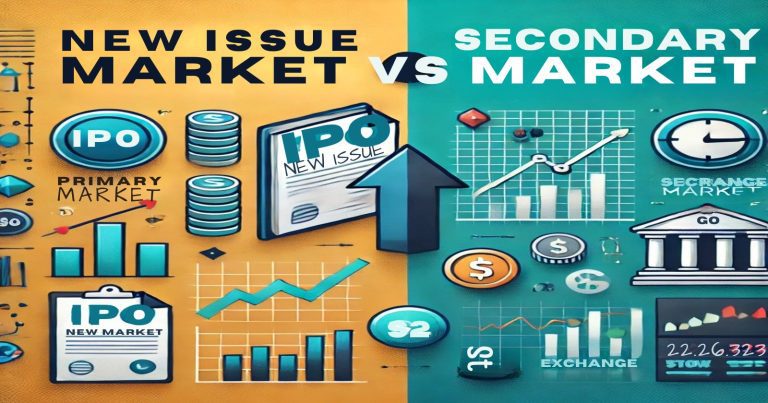New issue market vs secondary market is a matter of interest in which investors and financial enthusiasts find interest. While these two markets play critical roles in the financial ecosystem, they serve different purposes. The new issue market is involved with issues of fresh securities (shares/bonds), and the secondary market facilitates trading after issuing fresh securities. These markets have their differences, which must be understood when making the best investment decisions and grasping the more comprehensive operations of financial markets. In tandem, they promote business growth and operations as well as varied investor opportunities.
What is New Issue Market?
The new issue market, or primary market, is where the companies issue new securities to raise capital. It is the very first step in the lifecycle of securities, wherein they are offered to investors directly by the issuing company. This market is an important part of the financial system because it offers companies the necessary funds for expansion, operations, and other objectives.
Key Characteristics of New Issue Market
The New Issue Market plays a vital role in helping companies raise capital by issuing new securities. It serves as the primary channel for businesses to connect directly with investors and fund their growth initiatives.
- Purpose: The New Issue Market raises funds for businesses by issuing new securities through different means, including Initial Public Offerings (IPOs), rights issues, and private placements. These raised funds are primarily used to increase business, finance operational needs, or initiate a new project and are therefore essential for the development of a firm.
- Participants: Major participants in the New Issue Market are issuers, investors, underwriters, and financial institutions. All of these parties must collaborate to ensure that the process is smooth and that underwriters are responsible for managing risk and setting the terms of the issue.
- Pricing Mechanism: Securities in the New Issue Market are priced based on the company’s valuation, market conditions, and investor demand. The process often involves financial experts and underwriters who assess the company’s worth to attract potential investors.
- Direct Transactions: Investors buy securities directly from the issuer, bypassing intermediaries such as brokers. This direct contact is transparent and enables companies to develop a close relationship with their investors.
What is Secondary Market?
The secondary market, on the other hand, is a platform where already issued securities are traded among investors. This market does not involve the issuing company; instead, it allows investors to buy and sell securities among themselves, providing liquidity and marketability.
Key Characteristics of Secondary Market
The Secondary Market enables the trading of existing securities, providing investors with liquidity and flexibility. It plays a critical role in maintaining an active and efficient financial ecosystem.
- Purpose: The secondary market provides trading for existing securities, ensuring investors’ liquidity. It provides opportunities for investors to buy and sell securities, making it relatively easy to transform investments into liquid cash.
- Participants: The players in the Secondary Market include individual investors, institutional investors, brokers, and dealers. These participants make the marketplace dynamic, creating continuous trading activity with efficient price discovery.
- Pricing Mechanism: Prices in the Secondary Market are determined by market forces like demand and supply. Company performance, economic trends, and market sentiment are some of the factors that have a heavy influence on the pricing of securities.
- Intermediaries: Secondary Market deals are often passed through brokers; these intermediaries ensure smooth executions of trades while providing guidance to the investors. Their role is the backbone of how efficient and reliable the market happens to be.
New Issue Market vs Secondary Market
The financial market operates through two key segments: the New Issue Market and the Secondary Market. While the New Issue Market helps companies raise funds by issuing new securities, the Secondary Market facilitates the trading of existing securities, ensuring liquidity and efficient price discovery. Together, they drive economic and financial growth.
Nature of Transactions
The New Issue Market involves the issuance of new securities directly by companies to investors. This is the primary step where businesses raise funds by offering shares, Debentures (bonds), or other securities to public or private investors.
The Secondary Market, on the other hand, deals with the buying and selling of existing securities among investors. Here, the company that originally issued the securities is not involved in these transactions. Investors trade these securities through stock exchanges or over-the-counter markets.
Objective
The New Issue Market raises capital to promote operations and/or expansion or undertake other activities from companies. That is to provide direct funds directly to investors themselves.
The Secondary Market ensures that liquidity and marketability of securities are paramount. Investors can buy and sell their securities easily, allowing them the flexibility to change investments into cash at required moments.
Pricing Mechanism
In the New Issue Market, prices of securities are pre-determined by the issuing company in consultation with underwriters. These prices are often based on factors like company valuation, market conditions, and investor demand.
In the Secondary Market, prices of securities fluctuate based on demand and supply. Factors like market sentiment, company performance, and economic conditions impact the trading price of securities.
Participants
There are multiple participants in the New Issue Market, including the issuer of the securities, who is the company, investors, underwriters to assist in managing the process, and financial institutions for support.
The Secondary Market is comprised of individual investors, institutional investors, brokers, and dealers. These participants engage in buying and selling securities on the market and are essential in maintaining market activity and ensuring liquidity.
Role in the Financial System
The New Issue Market serves as a platform for companies to raise capital, supporting their growth and contributing to economic development. It is an essential step for businesses looking to fund new projects or expand operations.
The Secondary Market plays a key role in providing a trading platform for securities, enabling price discovery through market dynamics. It supports the financial system by offering liquidity, making it easier for investors to trade and manage their portfolios efficiently.
| Aspect | New Issue Market | Secondary Market |
| Nature of Transactions | Issuance of new securities by companies. | Trading of existing securities among investors. |
| Objective | Raises capital for companies. | Ensures liquidity and marketability. |
| Pricing Mechanism | Prices are set by the issuing company and underwriters. | Prices fluctuate with market demand and supply. |
| Participants | Issuers, investors, underwriters, financial institutions. | Individual and institutional investors, brokers, dealers. |
| Role in Financial System | Acts as a capital-raising platform. | Provides trading platform and price discovery. |
New Issue Market vs Secondary Market FAQs
What is the difference between the new issue market and the secondary market?
The new issue market refers to the issuance of new securities, whereas the secondary market involves trading among existing investors in existing securities.
Why is the new issue market significant?
The new issue market is important for raising capital and funding businesses to meet operational, growth, and other goals.
How does the secondary market promote liquidity?
It will make it easy to exit and hence ensure market liquidity. The investors can buy securities and sell these securities in this secondary market.
Whether Stock Exchanges comes under New Issues Market or the Secondary Market
These stock exchanges- NSE and BSE comprise of the Secondary Market where trading on existing securities takes place.
Can organizations raise funds under the secondary market?
No, companies cannot raise funds in the secondary market. They raise funds through the new issue market by way of an IPO, rights issue, or private placement.


